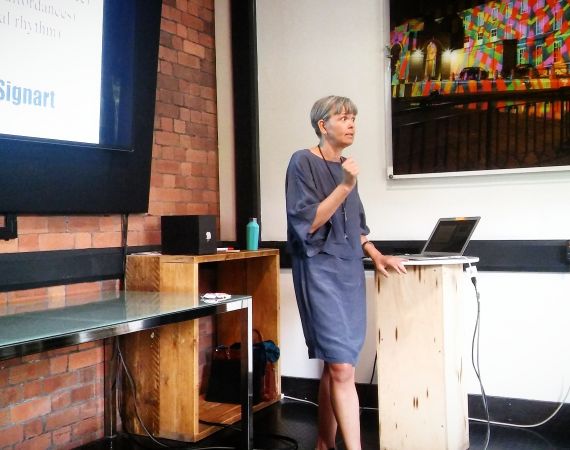Lunchtime talk write-up
Posted on Mon 19 Jun 2017
Can You Feel What I See?
Do we need to become fluent in sign language before we can begin to understand art created by our Deaf communities, or is there another way to appreciate their creative work?

Posted by
Speaker
Kyra Pollitt
Dr. Kyra Pollitt is a writer, artist and professional translator.Do we need to become fluent in sign language before we can begin to understand art created by our deaf communities, or is there another way to appreciate their creative work? Kyra Pollitt offered us a glimpse into the world of sign language arts, and explained why translation may be preventing us from getting it.
Kyra is a translator, poet, and artist, with a PhD on the properties of poetry in natural sign languages. Her practice takes art as translation and translation as art. She is interested in radical forms of translation that seek to capture such unspoken properties as the colour, sound and haptic qualities of movement.
Five Things I Learned
1. Kyra has been working in translation for over 20 years, and over the last six she has been practising and developing art as translation and translation as art; utilising words, signs, marks and movements. Kyra is careful not to use the term ‘sign language poetry’ as it creates problematic expectations of what boxes sign language poetry has to tick. Kyra prefers to use the term Signart to allow for a broader understanding of what the art form can involve. Kyra thinks existing translations of Signart can be reductive and many are done badly. Kyra’s practice incorporates Skopostheorie, an approach which focuses on translation as an activity with the aim or purpose of giving the intended audience of the translation the same experience as the audience of the original.
2. A Tale Told and Retold 2013 is an example of Kyra’s early radical translation work; a visual portrayal of a conversation between two women talking about car bumping into another in a car park. Kyra mapped out the ebbs and flows of their conversation matching the different intensities visually. It ended up looking like the Underground tube map, which inspired Kyra to boldly colour the lines. She then stitched them onto acetate. Kyra’s career has been all about translation, but she asked us, how important is it - since ‘the perfect translation’ is impossible between any two languages, spoken or signed.
3. Kyra wrote Signart: (British) Sign Language Poetry as Gesamtkunstwerk (or ‘synthesis of the arts’) for her PhD, which involved asking members of the deaf community what Signart was to them. Some of the responses were; “sign language is so immediate I can’t help but feel [the artist’s] presence” and “I feel I’m inhabiting the picture itself”. Kyra ascertained that Signart has certain qualities including poetic creativity, image making, the ability to mimic filmic language by speeding up or slowing down time, and a degree of Deafhood for authenticity (as a hearing person will always experience Signart differently).
4. Kyra experimented with translating a piece of Signart called Ocean by Johanna Mesch into concrete written poetry. Despite winning the Inside Arts Poetry Translation Prize 2012 Kyra felt that there was still room for improvement when translating Signart. Thus Experiments in Radical Translation 2 came along; members of public were invited to drop in and draw performing Signartists for a day. The swirling patterns and imagery indicated that people drew what they could feel and Kyra felt this was moving closer to what deaf people experience through performance.
5. For Experiments in Radical Translation 3 – Kyra worked with sign artist Paul Scott by filming his performance and projecting this huge scale all over walls, and ceilings to get across the all-encompassing physical presence of the Signartist. Kyra’s most recent piece is Experiments in Radical Translation 4 Air Poems in the Key of Sound 2017 – Kyra worked with vocalist Victoria Punch to map out the visual rhyming of Signart, then use vocal gestures to translate this into sounds. If you would like to see Kyra’s work for yourself she will be performing this piece at Ledbury Poetry Festival July 2017.
